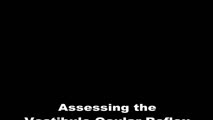A collection of videos relating to the diagnosis and treatment of eye movement disorders. This collection includes many demonstrations of examination techniques.
Dan Gold, D.O., Associate Professor of Neurology, Ophthalmology, Neurosurgery, Otolaryngology - Head & Neck Surgery, Emergency Medicine, and Medicine, The Johns Hopkins School of Medicine.
A collection of videos relating to the diagnosis and treatment of eye movement disorders.
NOVEL: https://novel.utah.edu/
TO
Filters: Collection: "ehsl_novel_gold"
| Title | Description | Type | ||
|---|---|---|---|---|
| 201 |
 |
Test Your Knowledge - Oscillopsia | This 65-year-old man with multiple sclerosis described that objects in front of him appear to spontaneously jump or move horizontally for the last few months. He reported that his symptoms occur independent of head movements and head impulse testing was normal. After viewing the video, what is the m... | Image/MovingImage |
| 202 |
 |
Test Your Knowledge - Acute Prolonged Vertigo | This is a 60-year old man with diabetes presenting with acute onset prolonged vertigo that was ongoing at the time of this examination. Which of the following statements are true with regard to the localization and/or etiology of this patient's symptoms? A. Whether or not symptoms worsen with head ... | Image/MovingImage |
| 203 |
 |
Test Your Knowledge - Monocular Oscillopsia | 𝗢𝗿𝗶𝗴𝗶𝗻𝗮𝗹 𝗗𝗲𝘀𝗰𝗿𝗶𝗽𝘁𝗶𝗼𝗻: Which of the following associated signs is most likely to be seen in this patient presenting with oscillopsia? A. Optic nerve pallor B. Palatal tremor C. Severe unilateral cataract D. Head bobbing E. Neurovascular contact... | Image/MovingImage |
| 204 |
 |
Test Your Knowledge - The Acute Vestibular Syndrome and Ptosis | What is the most likely localization in this patient presenting with vertical diplopia and acute onset prolonged vertigo? A. Right medial longitudinal fasciculus (MLF) B. Left medial longitudinal fasciculus C. Right medulla D. Left medulla E. Left midbrain A. Incorrect. A right MLF lesion (stroke, M... | Image/MovingImage |
| 205 |
 |
Gaze-Evoked and Centripetal Nystagmus in Creutzfeldt-Jakob Disease | This is a 65-year-old woman who experienced a progressive cerebellopathy over several months. Initially, she presented with mild gait imbalance and positional vertigo, and there was only apogeotropic positional nystagmus (more pronounced in supine roll test compared to Dix-Hallpike) with a very slig... | Image/MovingImage |
| 206 |
 |
Maddox Rod and Red Glass Testing | 𝗢𝗿𝗶𝗴𝗶𝗻𝗮𝗹 𝗗𝗲𝘀𝗰𝗿𝗶𝗽𝘁𝗶𝗼𝗻: Describing the basics of strabismus. | Text |
| 207 |
 |
Test Your Knowledge - Ocular Tilt Reaction and Subjective Visual Vertical | Lesions of which of the following neuro-anatomic structures could result in the clinical findings shown? A. Right medulla B. Right interstitial nucleus of Cajal C. Right medial longitudinal fasciculus D. Left trochlear nerve E. Right caudal midbrain A. Correct. This patient presents with elements... | Image/MovingImage |
| 208 |
 |
Test Your Knowledge - Optokinetic Nystagmus with a Parietal Lesion | 𝗢𝗿𝗶𝗴𝗶𝗻𝗮𝗹 𝗗𝗲𝘀𝗰𝗿𝗶𝗽𝘁𝗶𝗼𝗻: Given the finding seen in the first part of the video, which of the following associated features are most likely? (more than one answer may be correct) A. Left homonymous visual field defect B. Right homonymous visual fi... | Image/MovingImage |
| 209 |
 |
Measuring Divergence Amplitude | Divergence insufficiency should be suspected in patients with binocular horizontal diplopia at distance (but not near) who lack abduction deficits. There should be an esodeviation greater at distance, and in older patients with levator dehiscence (or previous ptosis surgery) and prominent superior s... | Image/MovingImage |
| 210 |
 |
Test Your Knowledge - Central and Peripheral Vestibular and Ocular Motor Signs Due to a Large Vestibular Schwannoma | Which of the following is least likely to be the correct localization or etiology given the findings seen in the video? 1) Acute right 8th cranial neuropathy 2) Right-sided vestibular schwannoma 3) Right vestibular nucleus infarction 4) Right anterior inferior cerebellar artery distribution stroke A... | Image/MovingImage |
| 211 |
 |
Test Your Knowledge - Vertical Saccadic Palsy Due to Bilateral riMLF Infarctions | This is a 30-year-old who was found minimally responsive on the lounge floor of an ice skating rink. He was brought to the ED, where he had a GCS score of 8 (where 15 is normal) for poor responsiveness. His ocular motor exam is shown in the video. Regarding Finding #1, which of the following is fals... | Image/MovingImage |
| 212 |
 |
Complete Microvascular 6th Nerve Palsy with Slow Abducting Saccade | 𝗢𝗿𝗶𝗴𝗶𝗻𝗮𝗹 𝗗𝗲𝘀𝗰𝗿𝗶𝗽𝘁𝗶𝗼𝗻: This is a 90-year-man with HTN, HLD, DM who woke up with horizontal diplopia. Two years prior, he was diagnosed with a microvascular right 6th nerve palsy that resolved over several months. There was little concern for gi... | Image/MovingImage |
| 213 |
 |
Test Your Knowledge - Bilateral 4th Nerve Palsies | Watch the video until instructed to stop. Which of the following features is likely to be present given her exam findings? A. Gaze-evoked nystagmus and impaired smooth pursuit B. History of traumatic brain injury C. History of blepharoplasty or brow lift surgery and prominence of superior sulcus on ... | Image/MovingImage |
| 214 |
 |
Test Your Knowledge - Parinaud's Syndrome in Neurosarcoidosis | Watch the first segment of the video up to "Stop! What would you expect with vertical gaze?" and select the best response below. The patient also has mild right-beating nystagmus which can be ignored for the purposes of this question. A. The patient has pupillary findings consistent with bilateral 3... | Image/MovingImage |
| 215 |
 |
Test Your Knowledge: The Acute Vestibular Syndrome with Gaze-Evoked Nystagmus and Bilaterally Abnormal Head Impulse Testing Due to Middle Cerebellar Peduncle and Flocculus Hemorrhage | This is a 70-year-old woman with a history of atrial fibrillation on warfarin presenting with acute prolonged vertigo and imbalance. In addition to the findings demonstrated in the first part of the video, what else should be seen to reassure the examiner that the etiology of her vertigo is benign? ... | Image/MovingImage |
| 216 |
 |
Approach to the Ocular Motor and Vestibular History and Examination | History and examination of ocular motor and vestibular. | Text |
| 217 |
 |
Oculopalatal Tremor and Internuclear Ophthalmoplegia Due to Hemorrhagic Pontine Cavernoma | 𝗢𝗿𝗶𝗴𝗶𝗻𝗮𝗹 𝗗𝗲𝘀𝗰𝗿𝗶𝗽𝘁𝗶𝗼𝗻: This is a 60-year-old woman who experienced 2 episodes of vertigo, nausea and vomiting, which was felt to be related to recurrent hemorrhage of a pontine cavernoma that was adjacent to the fourth ventricle. The cavernoma ... | Image/MovingImage |
| 218 |
 |
Oculopalatal Tremor and One-and-a-Half Syndrome Due to Pontine Hemorrhage | 𝗢𝗿𝗶𝗴𝗶𝗻𝗮𝗹 𝗗𝗲𝘀𝗰𝗿𝗶𝗽𝘁𝗶𝗼𝗻: This is a 65-year-old man who was put on a blood thinner, and shortly thereafter experienced a midline pontine hemorrhage, which was more dense on the left side. Immediately afterwards, right hemiparesis and hemi-anesthes... | Image/MovingImage |
| 219 |
 |
Slow Saccades Due to Unilateral Paramedian Pontine Reticular Formation (PPRF) Injury with Preserved Movements Using the Vestibulo-Ocular Reflex | 𝗢𝗿𝗶𝗴𝗶𝗻𝗮𝗹 𝗗𝗲𝘀𝗰𝗿𝗶𝗽𝘁𝗶𝗼𝗻: This is a 60-year-old man who presented for imbalance and oscillopsia 10 months after surgery and 8 months after radiation for Merkel cell carcinoma of the neck. He developed imbalance after surgery and diplopia and osci... | Image/MovingImage |
| 220 |
 |
Spontaneous Upbeat Nystagmus in Acute Wernicke's Encephalopathy | 𝗢𝗿𝗶𝗴𝗶𝗻𝗮𝗹 𝗗𝗲𝘀𝗰𝗿𝗶𝗽𝘁𝗶𝗼𝗻: This is a 40-year-old woman presenting with imbalance, confusion and oscillopsia. Exam demonstrated upbeat nystagmus (UBN) in primary gaze that remained UB in all directions of gaze, with a slight torsional component (top... | Image/MovingImage |
| 221 |
 |
Pendular, Gaze-Evoked and Abducting Nystagmus in MS | This is a 40-year-old woman with a history of multiple sclerosis who presented for oscillopsia. On examination, she had bilateral internuclear ophthalmoplegia (INO-adduction lag OU and abducting nystagmus OU), with a corresponding exotropia that increased in right and left gaze. She also had horiz... | Image/MovingImage |
| 222 |
 |
Downbeat Nystagmus and Cerebellar Atrophy | This is a 40-year-old man with 2 years of progressive ataxia and oscillopsia. On examination, he had downbeat nystagmus (DBN), an ocular motor finding that is usually (but not always) associated with flocculus/paraflocculus dysfunction, which causes overaction of the anterior canal (upward or anti-g... | Image/MovingImage |
| 223 |
 |
Impaired Smooth Pursuit and Other Characteristic Ocular Motor Findings in Middle Cerebellar Peduncle Stroke | 𝗢𝗿𝗶𝗴𝗶𝗻𝗮𝗹 𝗗𝗲𝘀𝗰𝗿𝗶𝗽𝘁𝗶𝗼𝗻: This is a 50-year-old woman who underwent resection of a left-sided acoustic neuroma, and post-operatively, she had vertigo, binocular diplopia, left hemi-ataxia and severe gait ataxia. MR diffusion weighted imaging demon... | Image/MovingImage |
| 224 |
 |
Assessing for Hyperventilation-induced Nystagmus | 𝗢𝗿𝗶𝗴𝗶𝗻𝗮𝗹 𝗗𝗲𝘀𝗰𝗿𝗶𝗽𝘁𝗶𝗼𝗻: Hyperventilation induced nystagmus is tested by asking the patient to take quick deep breaths (~1/s) for 40-60 seconds. This decreases ICP and increases CSF pH. This can be helpful in diagnosing irritative conditions of ... | Image/MovingImage |
| 225 |
 |
Dynamic Visual Acuity | 𝗢𝗿𝗶𝗴𝗶𝗻𝗮𝗹 𝗗𝗲𝘀𝗰𝗿𝗶𝗽𝘁𝗶𝗼𝗻: After assessing static binocular visual acuity, dynamic visual acuity (DVA) is determined by repeating the test during horizontal and vertical head shaking at 2-3 Hz. Dynamic visual acuity is most important to test when ... | Image/MovingImage |
